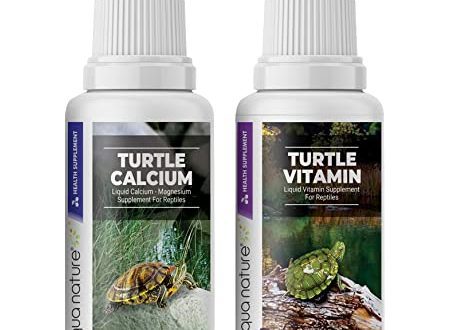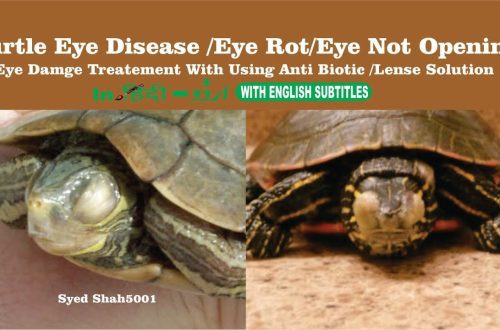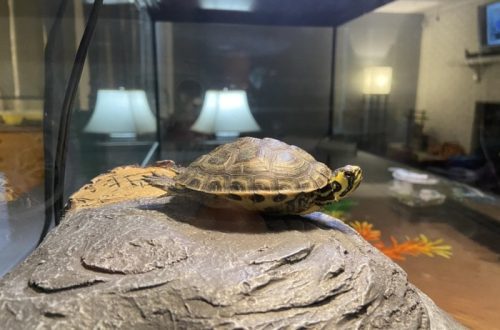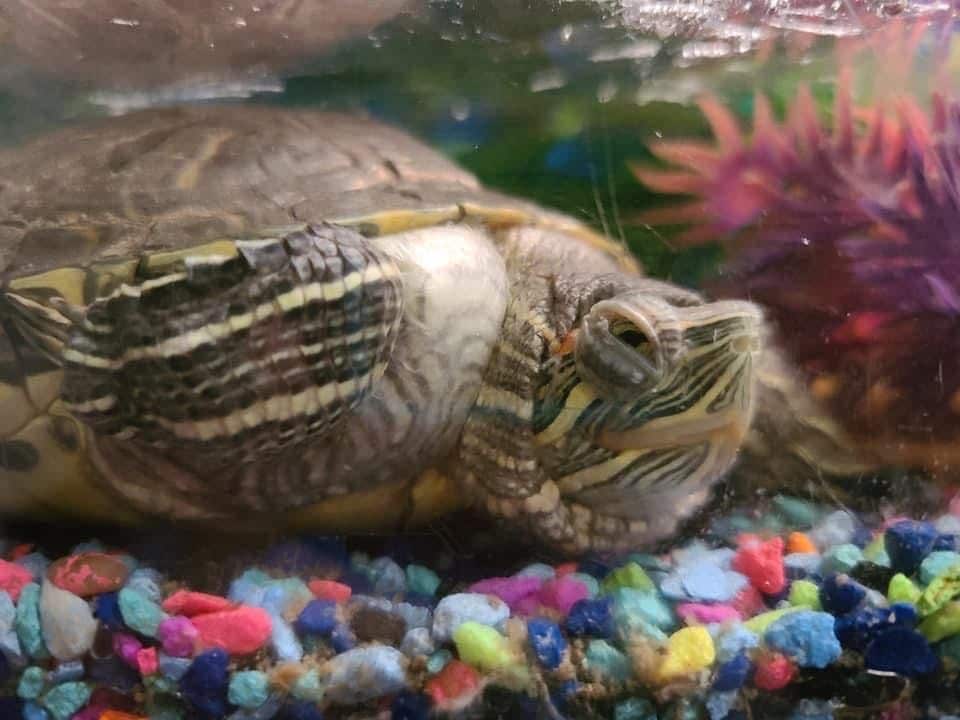
Eye diseases in red-eared turtles: symptoms and treatment
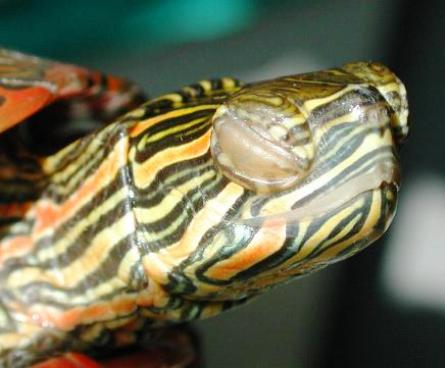
Eye problems in red-eared turtles are quite often a phenomenon caused by improper feeding of a four-legged pet, violation of feeding and hygiene standards. Sore eyes cause severe discomfort to the reptile, the animal ceases to navigate in space, becomes inactive and refuses to eat.
It is possible to cure the eyes of a red-eared turtle at home in the early stages of the disease, but quite often illiterate therapy or lack of treatment leads to partial or complete loss of vision.
Contents
The main symptoms of eye diseases
The eyes of a healthy turtle are always open and clear, without clouding of the lens, reddening of the conjunctiva and discharge. You can understand that a reptile has sore eyes by a characteristic clinical picture:
- the eyelids are very swollen in a reptile;
- the animal moves on land and in water with one or two eyes closed;
- yellow or white accumulations of pus are found in the corners of the eyes;
- there is profuse lacrimation, mucous or purulent discharge from the organs of vision;
- the mucous membrane of the eye is reddened, a curdled exudate may accumulate under the lower eyelid;
- clouding of the cornea occurs, sometimes whitish films are found on it;
- blepharospasm, photophobia and impaired eyeball movement may be observed;
- sometimes the animal violently rubs its eyes and nose with its paws.
A sick animal loses the ability to navigate well in space, as a result of which the pet cannot fully eat and move around. Against the background of the development of ophthalmic symptoms, the reptile develops lethargy and general weakness, the turtle refuses to feed and becomes inactive. Curing turtle eyes without determining the exact cause of the disease is quite problematic.
Swollen and closed eyelids are often symptoms of systemic diseases, so eye treatment will be effective only with therapy aimed at eliminating the cause of the pathology. Inflammation of the organs of vision in reptiles may be due to errors in feeding and maintenance: rare cleaning of the bottom and water, lack of a filtration system and an ultraviolet lamp, lack of vitamins A, D and calcium in the animal’s diet, keeping a pet in cold water.
Often, ophthalmic pathologies occur with metabolic disorders, viral, bacterial, parasitic, fungal or colds. Sometimes the cause of eye diseases is the advanced age of the water turtle, injuries and burns of the eyes, radiation or ultraviolet exposure, congenital anomalies and malformations of the organs of vision.
Treatment of diseases of the eyes of the red-eared turtle should be carried out under the supervision of a veterinarian or herpetologist after a comprehensive examination and diagnosis. The effectiveness of therapeutic measures directly depends on the timeliness of the pet owner contacting the clinic and the severity of the course of the pathological process, therefore, when the first symptoms of eye diseases are detected in the red-eared turtle, it is recommended to immediately seek help from doctors.
Eye diseases
Eye diseases in reptiles are one of the most common reasons why exotic pet owners seek veterinary advice. The following ophthalmic pathologies are diagnosed in aquatic turtles: conjunctivitis, panophthalmitis, eye burn, cataract, blepharoconjunctivitis, uveitis, keratitis, optic neuropathy, and blindness. It is impossible to restore lost vision to pets; the prognosis of treatment for eye pathologies can be from favorable to doubtful or unfavorable.
Conjunctivitis
Conjunctivitis is an inflammatory disease of the mucous membrane of the eye, which occurs when pathogenic microflora – streptococci and staphylococci – enters the conjunctiva.
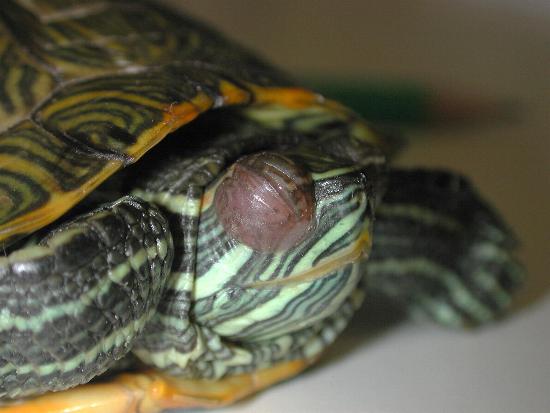
The cause of ophthalmic pathology in reptiles can be:
- dirty water;
- eye trauma;
- ingress of foreign bodies on the conjunctiva;
- allergies to strong odors, plant pollen or smoke;
- lack of vitamins.
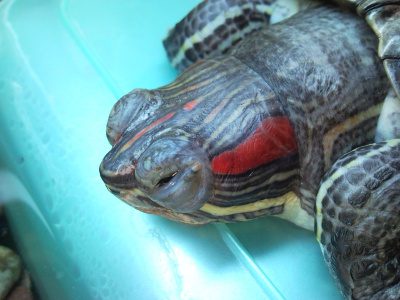
In a sick animal:
- swollen and watery eyes;
- the mucous membrane acquires a burgundy color;
- mucous and purulent discharge from the eyes and nose are observed;
- eyes stick together and swell;
- the animal stops eating and moving.
Panophthalmitis
An ophthalmic pathology in which all tissues of the eyeball are damaged is called panophthalmitis. Pathogenic microflora in this disease penetrates under the cornea of the eye from the oral cavity through the lacrimal canal. The first symptom of the disease is swelling of the lower eyelid and a slight clouding of the cornea, later, when all structures of the eyeball are destroyed by microorganisms, the reptile’s eye swells strongly, thickens, becomes white and cloudy. With delayed treatment, pathology leads to complete loss of vision.
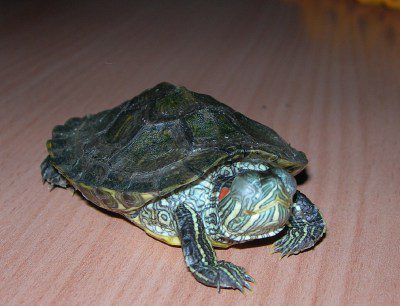
Burn
The main cause of eye burn in reptiles is improper installation of a source of ultraviolet radiation or the use of quartz lamps for turtles. You can also burn your pet’s eyes with hot objects, alkalis, acids, household chemicals or boiling water.
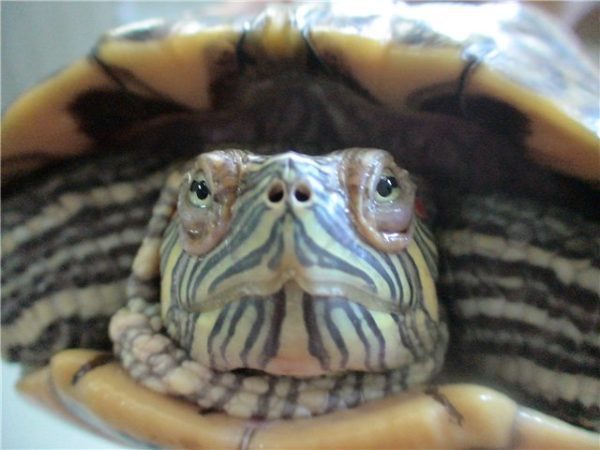
Depending on the severity of the eye burn, the reptile may experience the following symptoms:
- swelling of the eyelids;
- redness of the conjunctiva;
- corneal clouding;
- formation of gray films.
With a severe lesion, necrosis of the eyelids and all eye structures can occur, the skin of the eyelids turns black, and the eyeball becomes hard and white, like porcelain.
Cataract
A complete or partial lens of the eye is called a cataract, which translates as “waterfall”. From the name of the pathology, it becomes clear that the eye lens loses its ability to transmit sunlight, the pet perceives sunlight in a blurry form. The most common cause of cataracts is the old age of the reptile, although the disease can occur against the background of a lack of vitamin A, eye injuries, metabolic disorders, or congenital malformations. It does not make sense to treat the eyes of red-eared turtles with a diagnosis of cataracts; in people with this disease, a micro-surgery is performed with the replacement of the lens. Cataracts in reptiles cause complete loss of vision in the diseased eye.

Blepharoconjunctivitis
Inflammation of the eyelids and mucous membranes of the eyes in turtles is called blepharoconjunctivitis or marginal blepharitis. The most common cause of blepharoconjunctivitis in red-eared turtles is a lack of vitamin A in the body of a pet. Against the background of a lack of retinol, peeling of the skin occurs, resulting in blockage of the tear ducts by desquamated epithelium, inflammation of the conjunctiva and swelling of the eyelids.
In a sick turtle:
- swollen and closed eyes;
- redden and swollen eyelids;
- pus accumulates in the corners of the eye;
- discharge from the nose and eyes;
- refusal to eat;
- general edema of the body develops;
- the animal cannot retract the limbs and head into the shell.
In severe cases, blepharoconjunctivitis in turtles is complicated by renal failure.
Uveit
Uveitis is an inflammation of the vessels of the anterior chamber of the uveal canal of the eyeball. In red-eared turtles, uveitis occurs against the background of pneumonia, sepsis, general hypothermia, rhinitis, the cause of the pathology is often cold water or keeping the pet in a cold and damp room. Pathogenic microflora from the focus of inflammation penetrates into the subcorneal space of the eye, the organ of vision retains mobility and copes with its function. White-yellow pus accumulates under the lower eyelid, purulent discharge from the nose and eyes is observed, the reptile sneezes, refuses to eat, becomes very lethargic. The disease is characterized by severe depletion of the animal’s body.
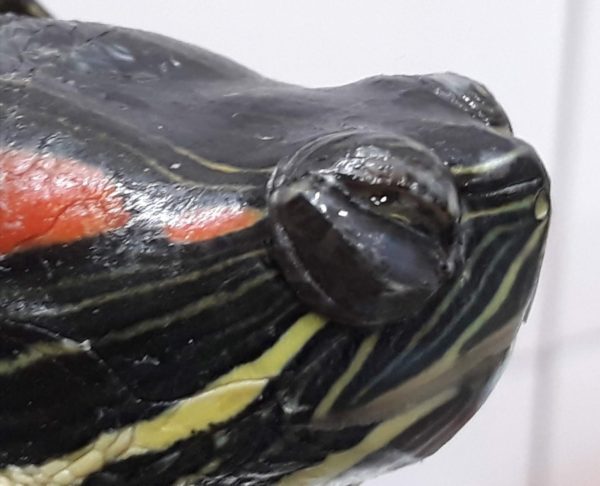
Keratitis
Inflammation of the cornea of the eye is called keratitis, which occurs as a result of injuries, burns, lack of vitamins, or is one of the symptoms of infectious and non-contagious diseases. The reproduction of pathogenic microflora in the cornea is accompanied by severe pain and discomfort for the reptile.
A sick turtle has:
- swelling of the eyelids;
- eyes are closed;
- lacrimation is observed;
- clouding of the cornea and redness of the conjunctiva;
- pet refuses to eat.
Severe keratitis is accompanied by severe ulceration of the cornea, which can lead to blindness.
Optic neuropathy
Infections, injuries, or eye burns in reptiles can cause optic neuropathy. In the red-eared turtle, retraction and loss of mobility of the eyeball, clouding of the cornea and lens are observed, the eyes of the animal are covered. Pathology inevitably leads to partial or complete loss of vision.
Treatment
The treatment of ophthalmic diseases in turtles should be handled by a competent specialist, the earlier therapeutic measures are prescribed, the more likely it is to save the eyesight and life of a pet. Self-medication without a diagnosis can cause the death of a little friend.
Conjunctivitis and eye burns can be cured on their own by washing the eyes of an aquatic animal with Ringer-Locke solution and instillation of anti-inflammatory drops of albucid, tobradex. It is necessary to instill veterinary drugs on the closed eye of a pet, followed by pulling back the lower eyelid so that the drop falls on the conjunctiva.
Blepharoconjunctivitis, uveitis, panophthalmitis, keratitis and complicated conjunctivitis in reptiles are treated with antibacterial drugs: decamethoxin, tsipromed, tsiprovet, tetracycline ointment. With itching of the eyes, hormonal preparations are prescribed simultaneously with antibiotics: Sofradex, Hydrocortisone. To increase the body’s resistance and achieve a positive effect of the therapy, turtles are prescribed injections of vitamins and immunostimulants.
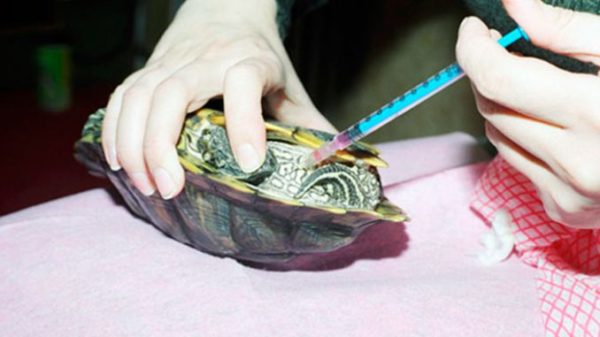 An important condition in the treatment of eye diseases is the limitation of the presence of the red-eared turtle in the water, the correction of the diet and conditions of detention. A sick reptile must be placed in a warm terrarium with a bathing tub installed in it, filled to a level of 2/3 of the pet’s body height. The animal should be irradiated daily under an ultraviolet lamp for reptiles and receive warm anti-inflammatory baths in chamomile decoction 2 times a day.
An important condition in the treatment of eye diseases is the limitation of the presence of the red-eared turtle in the water, the correction of the diet and conditions of detention. A sick reptile must be placed in a warm terrarium with a bathing tub installed in it, filled to a level of 2/3 of the pet’s body height. The animal should be irradiated daily under an ultraviolet lamp for reptiles and receive warm anti-inflammatory baths in chamomile decoction 2 times a day.
In the diet of a small patient, it is necessary to include calcium-containing feed of animal origin: sea fish, shrimp, squid, shellfish. The animal must receive fresh greens, carrots and cabbage. Once a week it is recommended to treat your pet with a liver.
Prevention
Most often, the cause of sore eyes in red-eared turtles is a banal violation of the norms of feeding and keeping aquatic animals, so the prevention of ophthalmic pathologies comes down to creating comfortable conditions for the existence of an exotic pet at home:
- spacious aquarium;
- water purification and heating system;
- regular washing and disinfection;
- the presence of an island;
- the presence of ultraviolet and fluorescent lamps;
- balanced diet;
- the use of vitamin and mineral supplements;
- regular examination of the eyes, shell and skin of the pet.
With an attentive and caring owner, water turtles are always healthy and live a long happy life. If even with quality care, the pet gets sick, you should not waste time and self-medicate, it is better to immediately consult a doctor.
Symptoms and treatment of eye diseases in red-eared turtles
4 (80%) 7 votes



